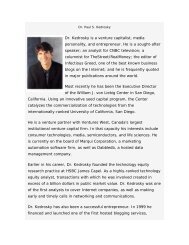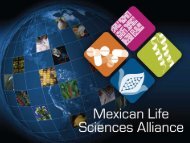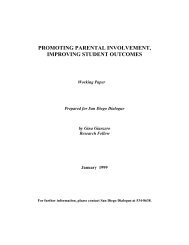Corridors and Clusters - San Diego Dialogue
Corridors and Clusters - San Diego Dialogue
Corridors and Clusters - San Diego Dialogue
You also want an ePaper? Increase the reach of your titles
YUMPU automatically turns print PDFs into web optimized ePapers that Google loves.
pharmaceuticals <strong>and</strong> biomedical devices; as well as high quality manufacturing; <strong>and</strong> global<br />
distribution.<br />
· Efficiency <strong>and</strong> reliability, which Baja California’s capabilities represent, are as important in<br />
manufacturing decisions in the high tech sector as is the cost of labor.<br />
· For the incubating R&D capabilities in Baja California, as well as the growing manufacturing<br />
sector, the ability to market alliances with R&D institutions on the United States side of the<br />
border would greatly enhance attractiveness for foreign investment <strong>and</strong> expansion in Mexico.<br />
· The superb educational institutions in fields relevant to R&D, high valueadded<br />
manufacturing, <strong>and</strong> professional development on both sides of the border enhance the<br />
attractiveness of the region to investors <strong>and</strong> companies.<br />
3.0 Recent Progress<br />
Recent activities suggest that the political will <strong>and</strong> ability to improve the economic interaction<br />
between <strong>San</strong> <strong>Diego</strong> <strong>and</strong> Baja California is emerging. During the past five years, progress has been<br />
made in underst<strong>and</strong>ing the relationship between the physical border <strong>and</strong> the local economy; in<br />
documenting border infrastructure needs; in the initiation of pilot planning programs that integrate<br />
economic development with border infrastructure development; <strong>and</strong> in the beginnings of a joint<br />
economic development strategy. These efforts have taken place in spite of ongoing challenges to<br />
cooperation as a result of the increased focus on border security following 9/11, the contentious<br />
debate in the US on immigration from Mexico, <strong>and</strong> the increase in drugrelated violence along the<br />
border, all of which have made facilitating crossborder economic activity a lower priority for policy<br />
makers. These small, but important steps indicate that where there is good data, clearly defined<br />
economic benefits, <strong>and</strong> political leadership from champions, progress can be made.<br />
The <strong>San</strong> <strong>Diego</strong>Baja California border crossing is one of the busiest in the world, both for pedestrians<br />
<strong>and</strong> products. In 2005, the <strong>San</strong> <strong>Diego</strong> Association of Governments (SANDAG) released its analysis<br />
of the economic impact of border crossing wait times. In that study, SANDAG found that congestion<br />
<strong>and</strong> delays at border ports of entry (POEs) for both personal <strong>and</strong> commercial border crossers cost the<br />
United States <strong>and</strong> Mexico nearly $6 billion in lost economic output <strong>and</strong> over 51,000 jobs in 2004<br />
based on an average 45minute wait. The majority of these losses were concentrated in the <strong>San</strong><br />
<strong>Diego</strong>Baja California region, totaling $4.2 billion <strong>and</strong> 42,000 jobs. 12 By 2007, these estimated<br />
losses had increased to $7.2 billion <strong>and</strong> 62,000 jobs for the US <strong>and</strong> Mexico combined, of which the<br />
<strong>San</strong> <strong>Diego</strong>Baja California region accounted for $5.1 billion <strong>and</strong> nearly 51,600 jobs. 13 The impact of<br />
foregone personal trips was much larger on the <strong>San</strong> <strong>Diego</strong> side of the border in terms of retail sales in<br />
the commercial sector <strong>and</strong> lost sales taxes revenue to the State of California. However, delays for<br />
truck crossings, averaging more than two hours, impacted Baja California more. Yet for both <strong>San</strong><br />
<strong>Diego</strong> <strong>and</strong> Baja California, these losses heavily affected the machinery <strong>and</strong> equipment sectors in<br />
terms of the efficient movement of goods.<br />
The significance of the model SANDAG developed in the course of assessing these impacts is that,<br />
for the first time, local, state, <strong>and</strong> national policy makers on both sides of the border have a clear<br />
12<br />
<strong>San</strong> <strong>Diego</strong> Association of Governments (SANDAG), Economic Impacts of Border Wait Times at the <strong>San</strong> <strong>Diego</strong><br />
Baja California Border, 2005.<br />
13<br />
SANDAG, 2007 Update: Economic Impacts of Border Wait Times at the <strong>San</strong> <strong>Diego</strong>Baja California Border,<br />
2007.<br />
6






